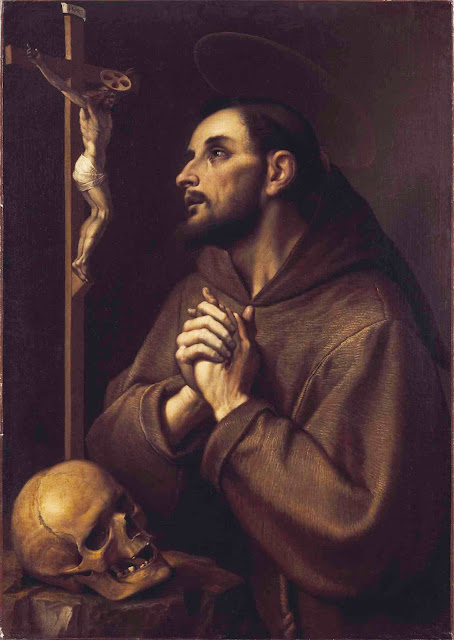Saint Francis by Jacopo Ligozzi 1596
Saint Francis adoring the Cross by Jacopo Ligozzi (1596). Oil on canvas
A versatile talent, Jacopo Ligozzi worked as a painter, draftsman, illuminator, printmaker, and designer of decorative objects. Known to have been a devout Catholic, he frequently depicted the subject of the life of Saint Francis. Founder of the Franciscan Order of monks and nuns, Francis of Assisi (about 1182–1226) is represented as intensely adoring a crucifix. His left hand shows stigmata—the wounds suffered by Christ when he was nailed to the cross. Francis miraculously received these wounds in a religious vision. A halo is visible above his head, signifying his sainthood. In the lower left, a skull rests on a stump, a reference to the theme of memento mori (remember death). In the painting’s context the skull is also an allusion to the transience of life on Earth juxtaposed with the life everlasting promised by Roman Catholicism (the same meaning is found in the Pendant Rosary with Skull in the nearby display case, which was used to count devotional prayers in the Catholic Rosary service).
Saint Francis Adoring the Cross presumably was commissioned for a patron’s private devotions, to encourage the viewer to emulate the extreme religious conviction of the saint. The restricted, monochromatic palette augments the painting’s emotional intensity.
This Saint Francis is inscribed with the artist’s monogram and is dated 1596. Thus it represents an example of Jacopo’s oeuvre as a painter towards the end of his second decade in Florence. His output during his early Florentine period was primarily characterised by tempera sheets depicting animals and plants, satisfying the personal and scientific interests of the Grand Duke Francesco I de’ Medici. It is only after 1593 that Ligozzi extensively devoted himself to religious painting, after he had left the service of the Grand Ducal court of Tuscany.
Saint Francis, immersed in the course of his devotions, is represented half-length, against the frontal plane of the picture. The image must be considered one of Ligozzi’s most exquisite paintings and the intensity of its emotional power in some ways foreshadow Guido Reni’s representations of twenty years later (See fig.1). Unlike the Reni, however, Ligozzi gives prominence to the skull or the theme of a memento mori. The skull signifies the transience of life on earth but together with the crucifix it indicates that the saint is contemplating the life everlasting. Both stylistically and expressivally the painting anticipates Ligozzi’s own later works in its almost proto-baroque character.
Ligozzi seems to have been attracted both by the subject matter of Saint Francis and to the religious order he had founded. In 1585 he supplied the engraver Andrea Andreani with a drawing depicting The Virgin and Child, with Saints Clare and Francis – the latter saint portrayed in the same solemn, deeply contemplative attitude. In 1589 Ligozzi was commissioned to execute a large painting on a Franciscan subject for the cloister of Bosco ai Frari in Mugello. A little later in 1595, he painted a Saint Didicus, his first work for the minority order of San Salvatore di Ognissanti in Florence. He continued working for the friars of Ognissanti until 1607 on a series of drawings and views illustrating the monastery of La Verna in the Casentino, the very site where Saint Francis had received the stigmata.
The general idea for the compositional scheme of this painting resembles that of a Saint Jerome, recently on the London Art Market – Fig.2, but the exhibited Saint Francis shows greater stylistic maturity so that it is perhaps more appropriate to compare it with later paintings, such as Saint Mary Magdalen in San Martino,Pisa of 1607.
Almost certainly commissioned by a patron for his private devotions, this probably accounts for the greater intimacy and the Counter-Reformation emphasis on piety and prayer.
We know from biographical sources that Ligozzi was notably devout, reading sacred texts and commentaries primarily centred on the Passion, encouraged by the spiritual direction of Fra’ Gabriele, one of his sons, a Dominican friar in Verona. The attitude of Saint Francis in this picture, in the act of adoring the crucified Christ, is in full accord with the artist’s personal inclinations and meditations. Such a modern and intense representation of piety may also be found in his Saint Jerome of 1593, in San Giovannino degli Scolopi. Archival sources indicate that Ligozzi painted another half-length Saint Francis in August 1593, for Vincenzo Gonzaga, Duke of Mantua and, well into the new century in 1618, he produced another large canvas of The Vision of Saint Francis, for the chapel of the villa of Poggio Imperiale near Florence, the residence of the dowager Grand Duchess, Cristina of Lorraine.
This image is a public domain image, which means either that copyright has expired in the image or the copyright holder has waived their copyright. Franciscan Gallery charges for the access to high resolution copy of the image. Manually restoration was necessary in order to improve quality, without covering the original image.





Comments
Post a Comment